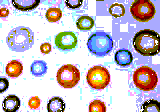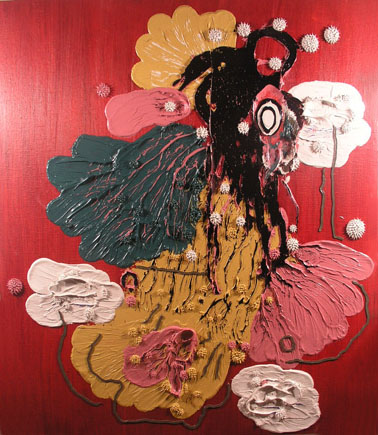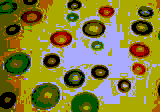View current page
...more recent posts

The Creepy Clown website has been mentioned here a few times (originally in this post) as an example of a populist, database-oriented art project that actually has some life to it. In all honesty, much of it is crap. For those who don't know, Creepy is a downloadable stock character made in a 3-D rendering program such as Bryce or Poser and plugged into a variety of situations and settings. The site formerly had a front page displaying some of the best Creepys, but now it's all grouped by artist and you have to slog through many inane pictures of Creepy making bunny ears behind George Bush's head to find what I consider the "classic Creepys." Fortunately I saved many of them from the original front page and offer them here as a public service. The ingredients of a classic Creepy are: (i) technically amazing rendering skills bumping up against the inherent "uncanny valley" artificiality of the program, (ii) a cheesy Americana or suburban setting, (iii) Creepy as a silent stalker, just standing there in a place he's not supposed to be. The best ones are chilling as well as dorky. The Creepy sitemeisters might not agree with these criteria; they seem to give equal weight to images (still!) of Creepy dismembering The Dancing Baby.

One recurring theme in the Rhizome.org blog panel tonight that is contradicted by Dennis Hollingsworth's blog: the idea that the art world always seeks to mystify and restrict access to the creator's output. Hollingsworth shows with Nicole Klagsbrun in New York and his work gets out there, as in, it's collected. He's a terrific painter and I thoroughly enjoyed the last show I saw at Klagsbrun. Complex stuff in the poMo ab-ex tradition, more seductive and paint-loving than, say, Jonathan Lasker (who I also like). Yet here Hollingsworth is on the web, letting you in on his studio process, both the physical making of paintings and his thinking about them. The above image is my slight cropping of a studio snapshot. More images are found in his post. He's a natural, talkative blogger and his step-by-steps are a gift to fans. Some artists protect their processes like trade secrets--Hollingsworth's openness shows his confidence that only he can make these paintings, and that online discussion only adds to their value, in the pure as well as commodity sense.
At the Rhizome.org panel tonight I recommended someone who I thought was a female blogger for a future panel--turns out that Amanda Congdon, while female, is actually part of a team. Rocketboom is a collaborative video blog produced by her, Andrew Baron, and Josh Kinberg. Congdon is an actress/comedian and the "face" of the project--not really "the" blogger, unless Rhizome were to invite all three of them. Still, the page is worth checking out--some very funny videos there in a fake news report format. Vote for Chris Christmas Rodriguez to Replace Santa Claus This Year and the news story on Topeka high school students abusing PHP are great. (hat tip to drat fink)
The panel was fun tonight, nice to meet everyone. Thanks to Francis Hwang for organizing it. And it was startling to see how many art world people turned out to hear about this hot phenomenon called blogging. Not. A few did, though--the cool ones.
The research paper on art blogs by Danish student Marie Omann, mentioned in an earlier post, has been published in PDF form on the MTAA blog. It's certainly relevant to the Rhizome.org panel on arts blogging tonight. I was flattered to see how much of her research came from posts and comments here, as well as to see all the input from the MTAA blog and Sally McKay's blog. Also on the MTAA site are questions posed to tonight's panelists by Rhizome Director of Technology Francis Hwang, and T.Whid's replies. I feel like I've been answering them all week so I'll save more specific replies for "meat space," as we unromantically call it. But here's just a quick recap of the last few posts on tonight's four panelists: who they are, what they do, and an attempt to make some connections through annoyingly brief summaries. (Oh, and before I forget, painter Dennis Hollingsworth also has posted answers to Marie Omann's questions on his blog. Dennis, no one said tonight's panel was going to be about "How can we use blogging in the artworld?")
David F. Gallagher
1. Photoblog of his own photos, and links to his big-media articles about blogging and other topics.
2. Subject of photoblog is New York City streets, but also travels elsewhere. Going to Italy with him vicariously was very enjoyable.
3. Interesting relationship between the photos as stand-alone art and the photos as components in a ongoing narrative. Occasionally the lines of his activities cross, as in his Slate article on the photoblogging phenomenon.
T.Whid
1. Photoblog documents activities of artist team MTAA (T. Whid + M.River), plus rants on politics and other subjects.
2. I'm shamefully undereducated on MTAA's total production, which is net art or new media work combining video and programming within a conceptual art framework--so I bluffed my way through a discussion of one recent piece and we had some back and forth about it on our weblogs.
3. According to M.River, the MTAA blog "has been designated to be 'not an artwork' but may contain some things that are artworks."
Kabir Carter
1. Sound blog that eschews recorded sound in favor of terse, poetic descriptions of sounds.
2. Subject is urban environment--New York City streets but occasionally other locations (e.g., someplace with beach sand and manatees). Incorporates "moblogging"--contemporaneous recording and posting to the Net of real world events through cell phones/handheld devices.
3. Blogging appears to be broken into discrete projects--bloglets? They are art, as opposed to documentation or work-in-process for something else. Net art using the blog medium, for want of a better description.
Tom Moody
1. Blog is documentation of ongoing studio production. Art objects (mostly abstraction, but occasionally portraits and dumb cartoons) made with the computer, but also music, animated .GIFs, and initial tentative stabs at video.
2. Blog veers wildly into narratives and rants on other subjects--politics, movies, electronic music, science fiction, etc. Oh, yeah, and art criticism.
3. The blog is not art but art often appears on the blog. Which explains the appearance of more medium-specific (browser-oriented) work such as animated GIFs since the blog began in 2001.
Great post by Steve Gilliard on why the "big" blogs (Atrios, Sullivan, etc.) are becoming more popular than established opinion journals, and more successful than sites from the dot-com era. It is relevant to our upcoming panel discussion on blogging and the arts not for its discussion of the profitability of blogs--though there's more to say on that--but rather what makes them "work" as a vehicle for content delivery where the dot-com sites failed and where print journalism seems lagging. Much that he says feels right in the art context, although no clear leader is emerging the way the bloggers he mentions dominate political discussion. That's probably just as well--art would be better served by a network of micro-specialized blogs and a few aggregator sites, as opposed to some uber-critic who had the power to influence careers and sales. It was very disturbing to move to NY almost 10 years ago and discover that NY Times critic Roberta Smith had the ability to sell out shows, and that she and Jerry Saltz were perceived to be the only game in town in terms of an artist's or gallery's financial success. The last thing we should want is a blogger with that kind of influence. As for selling ads, it seems to be working for political blogs to give the writers the autonomy to say whatever the fuck they want, but the same would not be the case with art-related blogs. Galleries don't have much to spend and expect some return on their investment. It's not just about "eyeballs."

I've been checking out a recent Rhizome proposal and related blogs by sound artist Kabir Carter, the fourth panelist in the upcoming blogging and the arts event. Carter's sound blogs (a term I'm using, not entirely accurate--more below) are linked to and described there as follows:
I say the term "sound blogs" isn't entirely accurate, because unlike, say, David F. Gallagher's photoblog, which also records urban details in a diaristic way, Carter's journals don't document sounds via regular posting of .mp3 files, but rather verbal descriptions of audial phenomena. Many of these short, pointed, often poetic statements enter the journals "moblog" style--as the artist notes above, he types them into a handheld device, on the spot, from the locations where they were heard. The entries resemble a foley artist's deadpan record of sound effects in a movie or TV storyboard. Many of the "sounds" are actually visual descriptions of sound-producing activities, followed by the word "(inaudible)."Effects
Effects is my first net project. Originally posted as a "stealth" LiveJournal blog, Effects purports to be a diaristic account of my life, but instead only offers dry accounts of sounds that I have heard, or imagine to have heard. While attempting to make LiveJournal friends who can track my accounts, I have periodically contributed to an ever growing catalog of acoustical accounts that never reveal much about me, but hopefully say many things about how I have experienced sound.
http://www.livejournal.com/~effects/Walking In The City
I am presently realizing Walking in the City, a project commissioned by Subtropics, a Miami based music festival. I moblog (in real time) written descriptions and accounts of acoustic occurences that I audit while walking around New York City. The project was launched during Subtropics' festival opening, where 4 hours of my updates from the city were projected live in an arts and performance space in Miami. Until early April, I will continue to intermittently add to the initial log.
SFX: Two Street Signs Affixed to Same Post Vibrating against One AnotherI'm reminded of the Kenneth Goldsmith piece where the artist transcribed every word he spoke for a week and hung the transcriptions in a gallery. Like Goldsmith's work we take it on faith the artist isn't making stuff up. But Carter's blogs aren't as obviously sequential: he's moving around the city, and readers often must rely on their own deductive faculties to tell how (or whether) the sounds relate to each other--especially in the subtropics blog, where there's no timestamp. A run of posts gives you a feeling of momentary total immersion in a cacophonous, slightly unhinged street scene, and then you're abruptly transported underground, into a subway environment that feels equally random but has its own characteristic sonic events. The sheer amount and complexity of detail paints a cumulative impression of the city not ultimately that dissimilar from Gallagher's far more "accurate" (as in verifiable) photographic record. Both conjure a teeming world beyond our normal mundane powers of observation.
SFX #234 SFX: Bell Struck
SFX #233 SFX: Two Small Dogs Barking in Unison
SFX #232 UNKNOWN PERSON: "Not my fault the watermelon tastes like..."
SFX #231 UNKNOWN PERSON: "Police officer, can you go to the end of the train? There's a guy with a bag and blue jeans."
SFX #230 SFX: Droplet Falling from Small Bent Conduit (Inaudible)
Reading Carter's blogs is highly recommended, although they would doubtless have a different kind of interest if you were one of those baffled LiveJournal Friends experiencing them in blog time--that is, following the posts as they appeared.

